Content editing is the process of reviewing and improving the overall structure, flow, and clarity of a piece of written content. It involves assessing the organization of ideas, ensuring coherence between paragraphs, and refining the language to enhance readability.
As someone who has edited thousands of words daily for over a decade, I can tell you that content editing is a crucial step in writing. So, if you’re looking to become a great editor, developing a solid understanding of content editing techniques is essential. I created this guide to help you improve your content editing skills.
I will provide you with practical tips and strategies to effectively assess and enhance the overall quality of written material. From understanding the target audience to identifying areas that need improvement, you will learn how to polish a piece of content to perfection. Let’s get started!
What Is Content Editing?
Content editing is a process that goes beyond simply checking for grammar and punctuation errors. It involves examining the content’s structure, organization, and flow to ensure it effectively communicates the intended message to the target audience.
Content editors analyze the clarity, coherence, and consistency of the writing, ensuring that each paragraph, sentence, and word serves a purpose and contributes to the overall effectiveness of the piece. Content editing may also involve checking for factual accuracy and consistency in the information presented.
Bonus Read: 5 Ways to Humanize AI Text
4 Types of Content Editing
To become a great editor, you must first understand the four types of content editing:
1. Developmental editing
Developmental editing focuses on the overall structure and organization of the content and sets the foundation for the whole editing process. As a developmental editor, you work closely with writers to refine ideas, identify gaps in the narrative, and suggest improvements to the piece’s flow and structure.
You can rearrange paragraphs, suggest adding or removing sections, and guide effectively conveying the intended message. Developmental editing is essential for ensuring the content is well-structured and engaging for the target audience.
2. Line editing
Line editing, also known as stylistic editing, focuses on the finer details of the writing. This includes improving sentence structure, word choice, and overall clarity. As a line editor, your role is to polish the language and make it more precise, engaging, and coherent.
You carefully examine each sentence, ensuring it flows smoothly and effectively communicates the author’s message. This type of editing requires a keen eye for grammar, punctuation, and syntax and an understanding of the writer’s style and tone. By refining the language, line editing enhances the overall readability and impact of the content.
3. Copyediting
Copyediting focuses on the mechanics of the writing, such as grammar, spelling, punctuation, and formatting. It involves correcting errors, ensuring consistency, and adhering to style guidelines. As a copyeditor, you carefully review each sentence, checking for typos, misspellings, and grammatical mistakes.
You also verify that the text is formatted correctly, with proper indentation, paragraph breaks, and headings. Additionally, you ensure that the writing follows punctuation and capitalization rules, making the text more professional and polished. This type of editing is essential for producing error-free and visually appealing content that is easy for readers to comprehend.
4. Proofreading
Proofreading is another vital task that editors undertake. In this stage, you meticulously read the entire text, word by word, to catch errors missed during the initial editing process. This includes checking for punctuation errors, such as misplaced commas or inconsistent use of quotation marks.
You also scrutinize the spelling of every word, ensuring that it is accurate and consistent throughout the document. Moreover, you pay close attention to grammar, ensuring that each sentence is structurally sound and that there are no instances of subject-verb agreement or tense inconsistencies.
Is Content Editing and Copy Editing the Same Thing?
Content editing and copy editing are not the same thing. While both involve reviewing and improving a written document, they focus on different aspects of the editing process. Content editing, also known as substantive editing, consists of evaluating the overall structure, organization, and clarity of the content.
It looks at the big picture, ensuring that the ideas flow logically and that the intended message is effectively communicated to the reader.
On the other hand, copy editing focuses on the finer details of the writing. It involves checking for grammar, punctuation, spelling, and syntax errors. Copy editors carefully review each sentence, word by word, to ensure spelling, punctuation, and formatting consistency throughout the document.
Still a bit fuzzy? You can read “Content Editing vs. Copyediting: 5 Key Differences” to learn more.
How do you decide which content editing aspects to prioritize?
When I first started editing content, I often got caught up in fixing minor details that had little impact on the piece’s overall quality. However, as I gained more experience, I learned to prioritize the most critical aspects of editing. This allowed me to focus on improving the content’s clarity, coherence, and effectiveness rather than getting bogged down by insignificant issues.
I always prioritize content editing aspects based on the overall goals and objectives of the writing. If the main aim is to convey a clear and compelling message, I focus on ensuring the content is well-organized, logical, and engaging. I also found the Eisenhower Decision Matrix Principle to be helpful. This principle involves categorizing tasks into four quadrants:
Important and urgent
This quadrant is reserved for tasks that are both important and urgent. These tasks require immediate attention and should be prioritized above all others. For content editing, this could include fixing critical errors, addressing significant inconsistencies, or refining the document’s overall structure. Ensuring the content meets the desired objectives and effectively communicates the intended message.
Example:
If you’re working on an organic marketing campaign, an essential and urgent task would be to review and revise the copy to ensure it aligns with the brand’s messaging and goals before it goes live. This quadrant requires immediate action to prevent any negative impact on the campaign’s success.
Important but not urgent
The tasks in this quadrant are essential but do not require immediate attention. They should be scheduled and given the necessary time and resources. When it comes to content editing, this could involve revising and refining the language, clarifying complex concepts, or improving the overall flow and coherence of the writing. These tasks contribute to the overall quality of the content and enhance its impact on the readers.
Example:
If you’re working on a blog post, consider spending time in this quadrant to ensure the content is engaging, informative, and well-structured. This could involve reorganizing paragraphs, adding subheadings for better readability, or incorporating relevant visuals to enhance the overall presentation.
Urgent but not important
This quadrant comprises tasks that are urgent but not necessarily important. While they may demand immediate action, they do not significantly impact the overall goals of the writing. Regarding content editing, these tasks include fixing minor grammatical errors, formatting inconsistencies, or addressing superficial issues.
While they should be addressed, they can be delegated or completed quickly without compromising the core message of the document.
Example:
If you’re working on a report that needs to be submitted by the end of the day but notice a few typos or formatting errors, addressing these issues would fall into the urgent but unimportant quadrant. By quickly fixing these minor errors, you ensure the document is visually appealing and free from distractions without spending too much time or effort on them.
Not urgent and not important
The tasks in this quadrant are neither urgent nor essential. They are low-priority and can be postponed or eliminated. In terms of content editing, these tasks could include minor revisions that have little impact on the overall quality or effectiveness of the writing. They can be addressed later or disregarded if they do not significantly contribute to the objectives.
Example:
If you’re working on a research paper, these tasks include fixing formatting issues, adjusting margins, or checking for consistent font usage. While these tasks may improve the document’s appearance, they do not affect the accuracy or clarity of the content. Therefore, it is essential to prioritize more pressing matters and only address these minor errors when time allows.
How to Edit Content Like a Pro in 8 Steps
Over the past 12 years, I’ve committed myself to developing a comprehensive process for editing content that produces professional results. I’ve observed the likes of Stephen King and Margaret Atwood and studied various editing techniques.
Through trial and error, I’ve refined my approach into an 8-step process that ensures every piece of content I edit is polished to perfection through trial and error. I’ve discovered that successful content editing requires combining technical skills, a keen eye for detail, and maintaining the author’s voice and intent.
Here’s how to edit content like a pro:
Step 1: Review the overall structure and flow of the content.
Identify any gaps or inconsistencies in the narrative and make note of them. This step involves analyzing the introduction, body paragraphs, headings, and conclusion to ensure a logical progression of ideas.
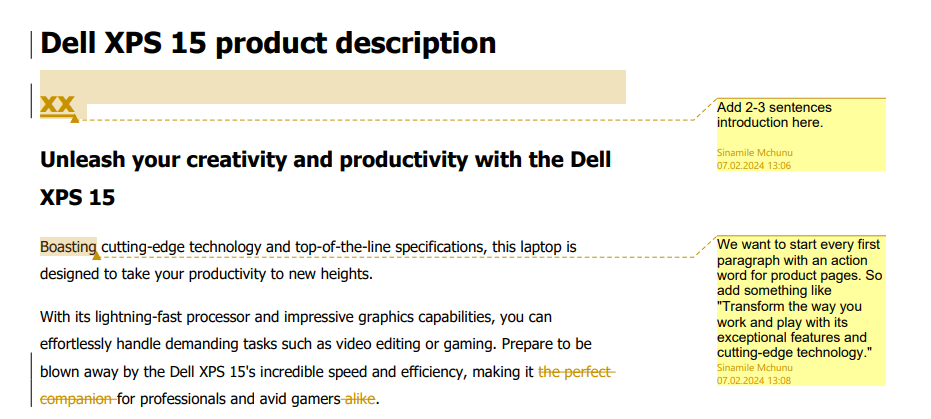
Additionally, it requires checking for any abrupt transitions or missing information that may confuse readers. Evaluating the content’s structure thoroughly sets a strong foundation for the editing process and allows for smooth readability.
Step 2: Ensure that the language used is clear and concise.
Ensure the language is concise and to the point, avoiding unnecessary wordiness or repetition. This involves condensing and simplifying sentences and removing any unnecessary or redundant information.
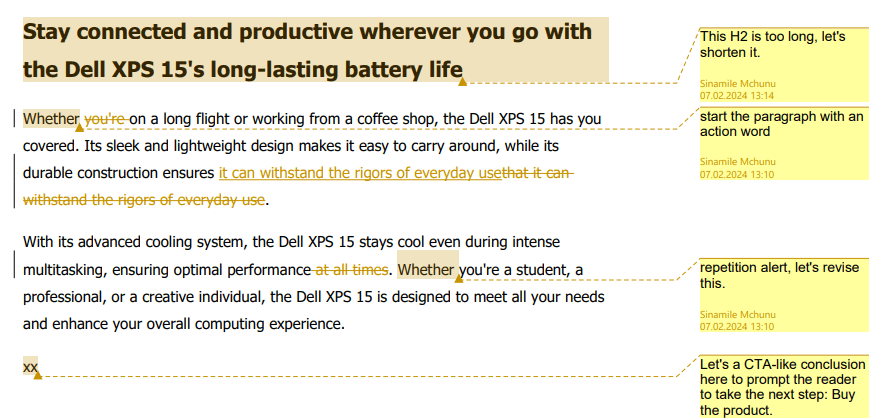
This step is crucial in ensuring the content is easy to understand and free from language errors or jargon that may distract or confuse readers.
Carefully review each sentence and paragraph, checking for proper grammar, spelling, and punctuation. This includes making sure that subject-verb agreement is consistent, verb tenses are used correctly, and there are no run-on sentences or fragments.
Step 3: Evaluate the clarity of the ideas and concepts presented in the content.
Make sure that the message is effectively communicated to the target audience. This step is crucial in ensuring that the information provided is clear and easily understood by the readers. It involves evaluating the coherence and logical flow of the ideas and the overall structure of the content. This includes checking for inconsistencies, contradictions, or gaps in the information.
Additionally, assess whether the content is engaging and relevant to the target audience and if it effectively addresses their needs and interests. By carefully evaluating the clarity of the ideas and concepts presented, you can ensure that the content is informative, concise, and easy to comprehend.
Step 4: Assess the appropriateness of the tone and style used.
Determine if the tone and style align with the intended purpose and desired brand image. The tone and style should reflect the values and personality of the brand and the expectations and preferences of the target audience. If the content is meant to be formal and professional, the tone should be formal, and the style should be concise and to the point.
On the other hand, if the content is meant to be friendly and casual, the tone can be more conversational, and the style can be more relaxed. Additionally, the tone and style should be consistent throughout the content to maintain a cohesive and cohesive brand image.
Step 5: Rearrange or rephrase sentences to enhance readability.
Take note of the paragraph arrangement and sentence form. Ensure that each sentence transitions easily into the next and that the paragraphs are organized logically. Transitional phrases and words can help the reader go from one thought to another.
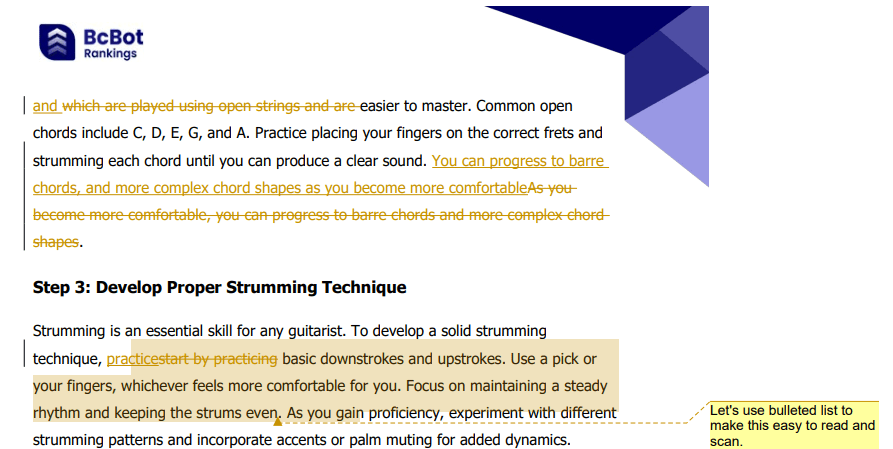
Experiment with different sentence lengths and structures to keep the reader interested.
To begin, divide big statements into small ones. As a result, the text will be more straightforward to read and understand. To arrange material and improve its visual appeal, advise the writer to utilize numbered lists or bullet points.
Step 6: Verify facts, figures, and references mentioned in the content.
Cross-check information to maintain accuracy and credibility in the writing. This step is crucial to ensuring that the information provided is reliable and trustworthy. Double-check any statistics, data, or quotes mentioned to avoid misleading the reader.

Ensure the writer includes hyperlinks or citations to reputable sources for added credibility.
Consider contacting specialists in the field to confirm the information offered. By establishing facts and references, you guarantee that the writer’s work is accurate and promote your brand as a trustworthy source of information.
Step 7: Provide constructive feedback and suggestions for improvement to the author.
Offer guidance on areas that can be further developed or expanded upon. This feedback should guide the author in the regions that can be further developed or expanded upon. Maintaining a respectful and supportive tone throughout the feedback process is crucial.
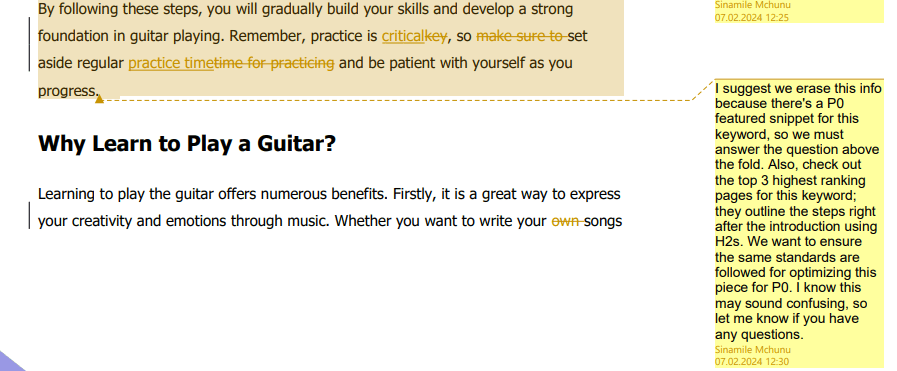
Additionally, offering specific examples and suggestions can help the author understand how to enhance their writing.
Encouraging the author to seek expert opinions or conduct further research on specific topics can add depth and credibility to their work. The goal is to help the author improve writing skills and create accurate, informative, and engaging content.
Step 8: Double-check for any remaining errors or inconsistencies before finalizing.
Before delivering the edited content to its author, perform a final review of all changes. This step ensures that the content is polished and ready for delivery to its author. Taking the time to complete a last review of all changes can help catch any overlooked mistakes and ensure the content is accurate, cohesive, and well-written.
Attend to proper grammar, spelling, punctuation, and formatting to guarantee a polished and flawless final output. To keep a consistent and coherent voice throughout the work, ensure the tone, style, and formatting are all consistent. You can ensure that the edited content is of the greatest caliber and prepared for return to the author by going above and beyond with these extra procedures.
Top 5 Content Editing Tools
We all know how technology has transformed how we create and consume content. Content editing tools have become essential for editors, writers, bloggers, and content creators. Here are my top five content editing tools to incorporate into your editing process:
1. Grammarly
Grammarly is one of the most popular content editing applications available. It looks for grammatical mistakes and provides ways to improve sentence structure and clarity.

Grammarly’s user-friendly design and powerful algorithms have made it a valuable tool for authors and content creators.
2. Hemingway Editor
Hemingway Editor is named after the legendary writer Ernest Hemingway and focuses on increasing the readability of your work.

It emphasizes convoluted sentences, excessive adverbs, and passive voice, simplifying your writing and making it more enjoyable for your viewers.
3. ProWritingAid
ProWritingAid is a comprehensive content editing tool that offers a wide range of features.

It analyzes your writing for grammar, style, readability, clichés, and more. With its detailed reports and suggestions, ProWritingAid helps you polish your content and elevate its quality.
4. Slick Write
Slick Write is a free online tool offering real-time writing feedback. It checks for grammar and spelling errors and provides insights into sentence structure, word choice, and overall style.

With its customizable settings, Slick Write allows you to tailor the editing process to your specific needs.
5. Autocrit
Autocrit is explicitly designed for fiction writers and authors. It focuses on pacing, dialogue, repetition, and vital writing techniques.
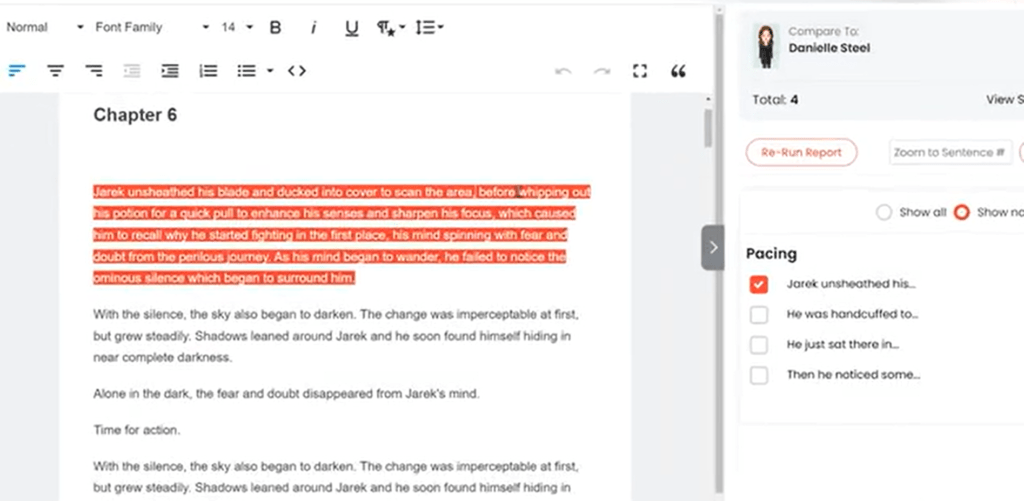
With its unique features, Autocrit helps writers refine their storytelling and create compelling narratives.
Final Thoughts
Content editing is more than just checking for spelling errors; it involves analyzing the overall flow and effectiveness of the writing. A professional editor can enhance the reader’s experience and ensure the message is conveyed effectively by focusing on the content’s structure, clarity, and coherence.
A content editor’s other duties include finding errors in the writing, enhancing the workflow, and polishing the language to produce polished and engaging work.


